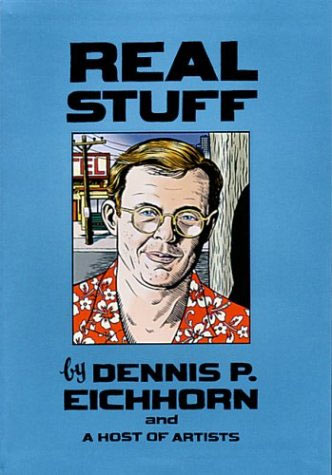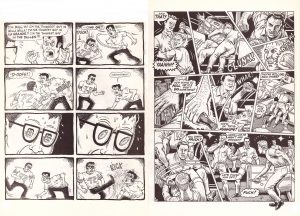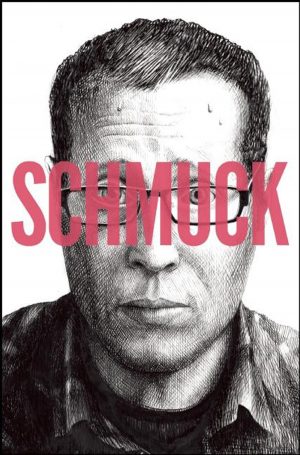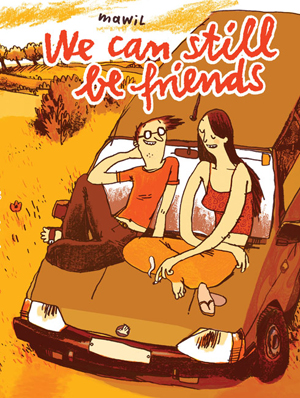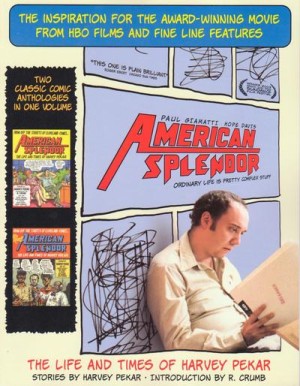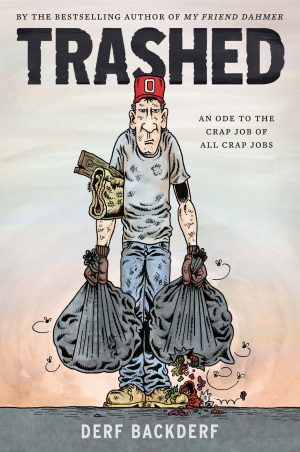Review by Frank Plowright
Dennis Eichhorn’s autobiographical tales flew in the face of most of his 1990s contemporaries. These weren’t the whining introspection common to the form, but ballsy bar anecdotes from a man who could handle himself, and who’d lived a life in which comics played only a small part. The meeting of storyteller and form was a revelation, and the era’s alternative cartoonists recognised this, almost queuing up to illustrate his recollections. Real Stuff packs in 43 of them, three to six pages being enough to cover most as Eichhorn says what he needs to say and moves on.
Eichhorn wrote these stories in his mid-forties, and there’s a vague chronology, beginning with his rural Idaho youth, and subsequent content sequenced so that two stories about Eichhorn’s time as a firefighter illustrated by Holly Tuttle and Jim Woodring follow each other. Eichhorn resists the temptation to comment on his past, avoiding any sense of soliciting approval, or forgiveness for being a dick in several anecdotes, although we arrive at Chester Brown and Seth illustrating how he eventually stopped picking fights after we’ve seen several. Points are made, and a wide emotional spectrum covered, but most content is funny, some set to raise a smile, others laugh out loud, while some defy all reason. The tone is set early with Dave Cooper making the most of Eichhorn remembering the guy in his neighbourhood parents warned their children to avoid. The reason becomes clear when the police have to extract his engorged penis from the neck of a bottle in the middle of the street.
In compiling the content Eichhorn has the commercial sense to prioritise the better known artists of the era like Julie Doucet, Mary Fleener, Roberta Gregory, Peter Kuper and Joe Sacco, rather than great stories drawn by enthusiastic, but less talented artists. Individual style is the order of the day, yet although the tone is affected by the art, there’s never a feeling of the art and story being mismatched. The sample spread has J. R. Williams and the team of Joe Zabel and Gary Dumm illustrating similar stories of fights and life-threatening situations, yet Williams’ style ensures a comic veneer. At the other end of the spectrum, Carel Moiseiwitsch’s monkey illustration is a nightmare-inducer.
That Eichhorn is a natural raconteur in person is confirmed by Peter Bagge, who illustrates his puzzled reaction to Eichhorn telling him of a time he was hired to walk up and down a guy’s back in flippers. Bagge also illustrates the most disgusting contribution, although that’s not an easy choice as this isn’t a selection for the easily offended or those with a weak stomach. Bagge takes great relish in presenting a close-up spread for the full gross-out effect. He and Holly Tuttle are the most frequently seen artists, with four strips from each included.
Extra Good Stuff followed in 2015, a welcome selection of all-new stories from Eichhorn, but that leaves around two-thirds of his 1990s output uncollected. Much of it is drawn by the artists featured, along with contributions from talented artists who aren’t as well known (Gene Fama and Kent Myers representing them here). That makes it worthwhile seeking out individual issues of Real Stuff, Real Schmuck and Real Smut.
Thanks to Rob Smentek for reference.
